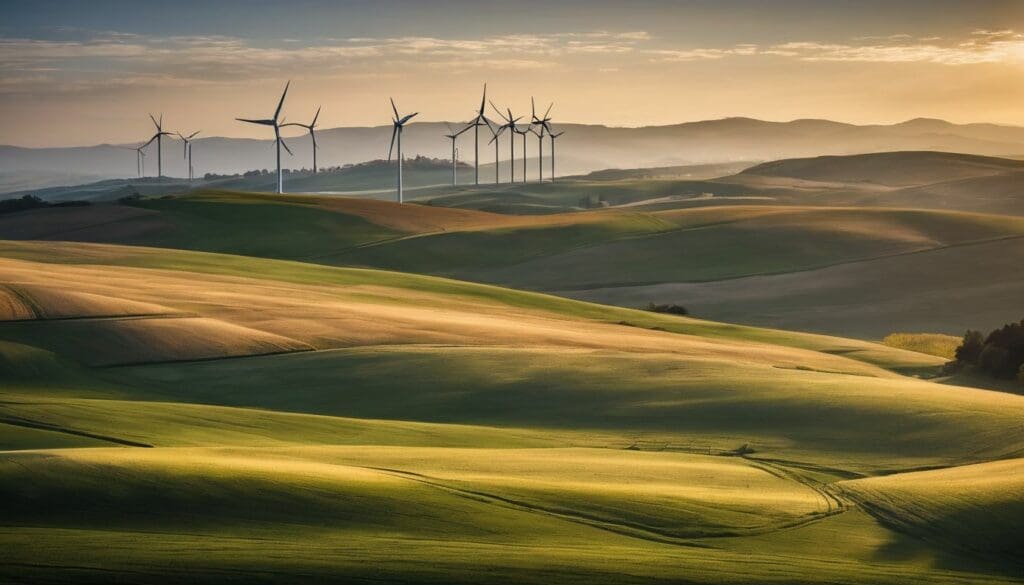As the world searches for clean energy, wind turbines stand tall in the race against fossil fuels. Remarkably, offshore wind farms can now produce enough electricity to power millions of homes.
This article will explore cutting-edge innovations reshaping wind turbine technology, making it more efficient and accessible than ever. Dive in for a whirlwind tour of the future’s energy giants!
Key Takeaways
- Airborne wind turbines are set to change the game by operating at higher altitudes, capturing more consistent winds and generating electricity more efficiently.
- Bladeless wind power is emerging as a groundbreaking innovation that minimises environmental impact, potentially reducing bird fatalities and noise pollution associated with traditional turbines.
- Wind turbine technology is advancing with the use of AI and robotics in manufacturing, leading to more precise production processes and predictive maintenance for better efficiency and durability of turbines.
- Innovations like wind turbine lenses focus airflow onto blades to enhance energy generation even at low wind speeds, promising greater output across various conditions.
- The industry sees a shift towards offshore floating turbines which can exploit stronger winds out at sea, significantly expanding potential locations for sustainable energy production.
Overview of Wind Turbine Technology
Wind turbine technology has come a long way, from traditional horizontal-axis turbines to the more innovative vertical-axis and offshore floating turbines. These advancements in design have led to higher efficiency and better utilisation of wind energy.
Traditional horizontal-axis turbines
Traditional horizontal-axis turbines tower above the landscape, their long blades slicing through the air. They are a common sight on wind farms around the world, known for their efficiency and ability to capture energy from high wind speeds.
These giants have been powering homes and businesses for decades, making them a trusted part of renewable energy solutions.
Designed with three blades that face into the wind, they typically stand atop tall towers to reach stronger winds at higher altitudes. As the most prevalent type of turbine in use today, they showcase advances like predictive maintenance and innovative manufacturing techniques like spiral welding.
The fundamental design remains unchanged: as winds blow, blades turn a rotor connected to a generator that produces electricity. Following this proven approach, we also explore alternative designs such as vertical-axis turbines which offer different benefits and challenges in harnessing wind power.
Vertical-axis turbines
Vertical-axis turbines, also known as VAWTs, are gaining attention in the wind energy sector. These turbines have vertical blades that rotate around a central axis, making them suitable for urban and low-wind conditions.
Their unique design allows them to capture wind from any direction without the need for realignment. This makes VAWTs an appealing option for sustainable energy solutions in densely populated areas where space is limited.
Taking advantage of their ability to harness wind energy efficiently at low speeds, vertical-axis turbines provide an innovative alternative to traditional horizontal-axis designs.
With ongoing improvements in technology and manufacturing processes, these turbines are poised to play a significant role in expanding access to clean and renewable energy sources across diverse landscapes.
Moving forward, understanding the advancements and potential applications of vertical-axis turbines will be crucial for shaping the future of wind turbine technology and meeting global energy demands sustainably.
Offshore floating turbines
Offshore floating turbines have emerged as a groundbreaking solution for harnessing wind power in deeper waters where traditional fixed-bottom structures are not feasible. These innovative turbines are anchored to the seabed using mooring lines, allowing them to float and capture wind energy more effectively.
By utilising these floating platforms, offshore wind farms can be installed further out at sea, tapping into stronger and more consistent wind resources. The development of offshore floating turbines represents a significant advancement in expanding the potential of offshore wind energy production, paving the way for greater sustainability and renewable energy generation.
The next segment explores the latest innovations in wind turbine technology with a focus on airbone wind turbines.
Latest Innovations in Wind Turbine Technology
From airborne wind turbines to low speed wind power and bladeless wind power, the latest innovations in wind turbine technology are revolutionising the way we harness renewable energy.
These advancements are making wind energy more efficient, sustainable and accessible than ever before.
Airborne wind turbines
Airborne wind turbines, also known as flying wind farms, harness energy using large kites or drones attached to a generator. These innovative turbines operate at higher altitudes than traditional ones, taking advantage of stronger and more consistent winds.
By accessing these powerful air currents, airborne wind turbines can generate electricity more efficiently and cost-effectively. This pioneering technology has the potential to significantly increase renewable energy production while minimising environmental impact.
Low speed wind power
Low speed wind power is a promising innovation in wind turbine technology. It entails the development of specialised turbines that are optimised to capture energy from low wind speeds, making it possible to generate power even in areas with less consistent winds.
These turbines are designed with enhanced blade shapes and configurations, along with advanced control systems, allowing for efficient energy production at lower wind velocities.
Moreover, low speed wind power offers the potential to expand the geographic range for wind energy production, opening up new opportunities in regions previously considered unsuitable for traditional high-speed turbines.
Bladeless wind power
Moving on from low-speed wind power, a fascinating innovation in wind turbine technology is the development of bladeless wind power. Unlike traditional turbine designs with spinning blades, bladeless wind turbines use a different approach to harness the power of the wind.
By capturing energy through oscillation instead of rotation, these turbines have the potential to reduce bird and bat fatalities often associated with traditional turbines. Additionally, they generate less noise pollution and require minimal maintenance due to their simpler design.
Bladeless wind power presents an exciting alternative for those seeking sustainable energy solutions that minimise environmental impact while maximising energy production. With its innovative design and promising advantages, it adds a new dimension to the world of renewable energy technology.
Wind turbine lenses
Moving from the concept of bladeless wind power, another innovative development in wind turbine technology is the use of special lenses. These lenses are designed to improve the efficiency and output of wind turbines by focusing and redirecting incoming wind to increase energy production.
By concentrating the airflow onto the turbine blades, these lenses help maximise energy generation even in low-wind conditions.
The implementation of wind turbine lenses presents a promising advancement towards enhancing sustainable energy solutions. This approach aims to optimise the performance of wind turbines, contributing to increased renewable energy production while aligning with environmentally conscious practices for a greener future.
Quiet turbines
Quiet turbines have been a significant advancement in wind turbine technology. By reducing noise pollution, they address concerns of nearby residents and wildlife. These innovative designs utilise sound-reducing features without compromising energy production.
These quiet turbines harness the power of wind while being considerate of their surroundings. They are an essential development for sustainable energy solutions, promoting harmony between green technology and local environments.
Wind power storage
Transitioning from quiet turbines, another exciting development in wind turbine technology is wind power storage. This innovation addresses the issue of intermittency in wind energy production by storing excess power generated during peak periods for use at a later time.
This advancement ensures a consistent and reliable supply of renewable energy, contributing to increased efficiency and stability within the overall energy grid.
Advances in Manufacturing Techniques
Manufacturing wind turbine towers using spiral welding techniques can increase their strength and reduce construction time, making them more cost-effective and efficient. Read on to learn about the latest innovations in wind turbine technology that are shaping the future of sustainable energy.
Use of AI and robotics
AI and robotics have revolutionised wind turbine manufacturing, improving efficiency and precision. Advanced algorithms analyse data to optimise production processes, reducing waste and energy consumption.
Robotics are used for intricate tasks like blade manufacturing and assembly, ensuring high-quality output. This combination of AI and robotics not only enhances productivity but also contributes to sustainable energy solutions by minimising environmental impact through efficient manufacturing techniques.
These technologies also play a crucial role in predictive maintenance, where AI algorithms analyse sensor data to predict potential issues before they occur, enabling timely interventions to prevent downtime and extend the lifespan of wind turbines.
Digital twins
Wind turbine technology has made significant strides with the development of digital twins. These virtual replicas provide real-time insights into wind turbine performance, enabling predictive maintenance to prevent potential issues.
Digital twins use data from sensors and turbines to create accurate models that can predict maintenance needs, optimise performance, and reduce downtime. This innovative technology plays a crucial role in ensuring the efficient operation of wind turbines while contributing to sustainable energy production.
As an environmentally conscious individual interested in supporting conservation efforts, understanding the impact of digital twins on wind turbine technology is vital for embracing sustainable energy solutions.
The Future of Wind Energy
As new technologies continue to evolve, the future of wind energy looks promising with advancements in efficiency, storage capabilities, and global trends shaping the industry. Read on to explore the latest innovations in wind turbine technology and their impact on the sustainable energy sector.
Global trends and developments
The global wind energy sector is experiencing significant growth, with emerging trends and developments shaping the industry. Governments worldwide are increasingly investing in renewable energy sources, placing a strong emphasis on wind power as a key contributor to sustainable energy production.
Additionally, advancements in technology and manufacturing processes continue to drive down the cost of wind-generated electricity, making it more competitive against traditional fossil fuels.
Moreover, there is a growing focus on offshore wind farms due to their potential for higher yields and reduced environmental impact. Furthermore, innovative storage solutions are being developed to address the intermittent nature of wind power, enabling a more reliable and consistent supply of clean energy.
Impact of new technologies on the industry
New wind turbine technologies are revolutionising the industry, contributing to increased efficiency and reduced environmental impact. Innovations such as airborne wind turbines, low speed wind power, and bladeless wind power offer promising alternatives for sustainable energy production.
These advancements have the potential to bolster the adoption of wind energy on a global scale, marking a significant shift towards green and renewable sources of power.
Moreover, the integration of AI and robotics in manufacturing processes has enhanced productivity while reducing costs associated with wind turbine production. The advent of predictive maintenance technologies ensures that turbines operate at optimal levels, fostering greater reliability and longevity within the industry.
Conclusion
Innovations in wind turbine technology are shaping the future of sustainable energy. Airborne turbines and bladeless designs are revolutionising wind power generation. Manufacturing advancements using AI and robotics are increasing efficiency and reducing costs.
The industry is moving towards quieter, more efficient modular wind systems to meet the growing global demand for green energy.
FAQs
1. What are the latest innovations in wind turbine technology?
The latest advancements include floating wind turbines for offshore use, modular wind systems for easier installation, and spiral welding techniques that strengthen tower manufacturing.
2. How do floating wind turbines work?
Floating wind turbines can be anchored in deep waters far from shore to harness powerful ocean winds and generate alternative energy.
3. Can new wind turbine technologies improve energy output?
Yes, modern adaptations such as predictive maintenance increase turbine efficiency by preventing breakdowns before they happen.
4. Are there any advances that make building wind turbines better for the environment?
Sustainable technology like recyclable blades and improvements in manufacturing processes ensure that creating and operating turbines is green and environmentally friendly.
5. Why is it important to keep innovating with wind turbine technology?
Wind energy innovation helps us find even better ways of capturing the natural power of the wind to support a clean, sustainable future with reliable green energy sources.





